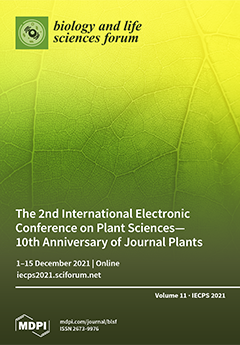Hemp (
Cannabis sativa L.) has been known as a source of fibres, oil and medicines since ancient times (4000 B.C.). Currently, there is an increasing interest in fibrous hemp as a source of compounds with pharmacological activity. Cannabis is rich in biologically active compounds such as terpenes, flavonoids, sugars, alkaloids and the most well-known unique cannabinoids including psychoactive Δ
9-tetrahydrocannabinol (THC), Δ
9-tetrahydrocannabinolic acid (THCA) and non-psychoactive cannabidiol (CBD), cannabidiolic acid (CBDA). Quickly increasing interest in using low-THC (<0.2%) hemp requires the development of efficient methods for extracting bioactive substances. Conventional methods of cannabinoid extraction, such as Soxhlet extraction or maceration, require longer extraction times and large amounts of solvent. The addition of ultrasounds or mixing may support the process of extracting bioactive compounds. The aim of the study was to compare CBD extraction methods for
Cannabis sativa. For extraction with ethanol (40%, 60% and 80%), fresh panicles of monoecious hemp variety Beniko (2.55% CBD and 0.06% THC), allowed for cultivation in Europe, were selected. After harvesting, the panicles were frozen in liquid nitrogen and stored in a freezer (−20 °C). For extraction, dynamic maceration was used, during which, the plant material was shaken in the dark (100 rpm, 72 h), and ultrasound-assisted extraction was carried out (45 Hz, 0.5 h). Analysis showed the highest content of CBD (361.3 µg/mL) during extraction with 80% ethanol combined with ultrasound. On the other hand, dynamic extraction with 60% ethanol allowed us to obtain 352.7 µg/mL of CBD. In the case of ultrasound-assisted extraction, a significantly lower content of CBD was observed at the 303.4 µg/mL level for extraction, with 40% and 301.4 µg/mL for 60% ethanol in comparison with the higher content of CBD (361.3 µg/mL) obtained during extraction with 80% ethanol. In contrast, dynamic maceration with 40% ethanol showed a significantly low content of CBD at the 252.6 µg/mL level, and the application of 60% ethanol increased CBD content to 352.7 µg/mL, which was significantly high, whereas extraction with 80% ethanol provided 331.9 µg/mL of CBD. In addition, extraction with dynamic maceration revealed significant differences in level of THC, and in 40% ethanol, the lowest content THC (10.0 µg/mL) was observed, and in 80% ethanol, the highest content of THC (17.7 µg/mL) was observed. Ultrasound-assisted extraction showed unimportant changes in the level of THC from 11.4 µg/mL in 40% ethanol to 15.6 µg/mL in 80% ethanol, respectively. The use of ultrasound supported the extraction by faster mass transfer and uniform mixing, which accelerated the extraction of compounds, which was shown in the extraction with 80% ethanol. A similar effect at a lower ethanol concentration (60%) was observed when dynamic maceration was used. The obtained results indicate that the most efficient method of extraction is ultrasound-assisted extraction; however, dynamic maceration with shaking may be an alternative method. These methods can be used to obtain high-quality extracts containing bioactive compounds for pharmaceutical purposes and food production.
Full article



